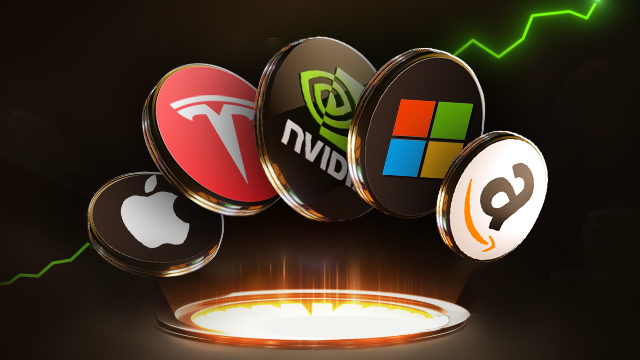TQQQ250425C22000
- 30.92
- +2.00+6.92%
ProShares UltraPro QQQ ETF Newsroom
Biggest Stock Movers Monday: TM, AMPY, and More
The Value Sector Pummeling the Magnificent 7
Options Plays Ahead of Earnings: AAPL, AMZN, META, MSFT
Market Technical Analysis: Will the US Stock Market's Rebound Ignite Your Next Trade?
Bill Ackman Hails Jeff Bezos-Backed Tesla Rival Slate Auto, Says It Will Be 'A Big Success'
The US stock market is facing a major test with Technology Earnings Reports, but good news is no longer able to lift the market.
Research indicates that in the current macro environment, companies with better-than-expected performance see an average increase of only 50 basis points the next day (T+1), significantly lower than the historical average of 101 basis points. Meanwhile, companies that do not meet expectations experience a drop of 247 basis points, which is more severe than the historical average decline of 206 basis points.
The USD has slightly increased, benefiting from the de-escalation of trade frictions and alleviated concerns about the independence of the Federal Reserve.
The US dollar showed a mild upward trend at the beginning of this week, supported by market expectations of easing global trade tensions and reduced risks to the independence of the Federal Reserve. Last week, President Trump announced progress in trade negotiations with Japan and clearly stated there was no intention to dismiss Federal Reserve Chairman Powell.
Just last week, the US stock market formed the strongest Call pattern.
If within 10 days, the proportion of rising Stocks on the NYSE exceeds 61.5% from less than 40%, it triggers a ZBT signal, which often indicates that the market has rapidly shifted from extreme overselling to extreme overbuying. According to Bank of America analysis, since 1939, every time a ZBT signal appeared, the S&P 500 Index has risen in the following 130 and 190 trading days, with average gains of 17.1% and 19.6% respectively.
Analyst Casts Doubt On Apple's Reported Move To Shift iPhone Production To India Amid Rising China Tariff Pressures: 'Doesn't Solve All The Problems'
Cathie Wood Sees Palantir Dominating Enterprise AI, Wonders How Microsoft Will Manage 'Massive Disruption' — Will Excel Finally Die?
The enthusiasm for Datacenters has not diminished, but the giants have indeed pressed the "pause button."
Analysis indicates that overall capital expenditure in AI remains strong, and market demand is not retreating but is rather in a "temporary pause." According to McKinsey's forecast, the Datacenter market is expected to maintain a growth range of 20% to 25% over the next five to seven years, although the growth rate will fluctuate year by year.
The pattern of the Chinese smartphone market changed in the first quarter: Xiaomi topped the chart for the first time in ten years, while Apple's market share declined.
① The Analyst believes that the main reasons for Xiaomi's rise to the top are the optimization of its channel system and the national subsidy policy for purchasing devices. ② The overall market fundamentals remain relatively weak, and the shipment volume has not yet recovered to the level of the same period before the pandemic.
As the earnings reports season comes to a close, can the profit growth of technology giants keep up with the expansion of their valuations?
This week, Microsoft, Apple, Meta Platforms, and Amazon will report quarterly results in a market affected by concerns over economic recession caused by trade wars and tariffs.
Be cautious during the Earnings Reports season! Goldman Sachs is urgently applying the brakes: AI support cannot hide the shrinking corporate wallets.
Goldman Sachs' chief US equity strategist warns: next week, 41% of the S&P 500 constituents will disclose their earnings, and corporate investment decisions may hit the brakes due to increasing policy uncertainty.
Economic officials of "Trump 1.0" state that the impact of tariffs will become apparent nationwide by the end of next month, with the poorest suffering the most.
The former director of the White House National Economic Council stated that the "soft data" reflecting future expectations is weakening; before commodity prices rise due to tariffs, those with lower income levels or economic strength will use 100% of their salaries to purchase commodities, while the wealthy will save a higher proportion of their income, with the former being more severely impacted.
Sam Altman Admits ChatGPT New Upgrade Made It Too Sycophantic And Annoying: OpenAI CEO Says 'Working On Fixes ASAP'
Chamath Palihapitiya Says Nvidia Is Huawei's 'New Target' — A 'National Champion' That Crushed Tech Giants With A 'Low-End Disruptor' Strategy
Goldman Sachs warns behind the technology stock frenzy: the rise of U.S. stocks cannot mask the dual concerns of valuation and policy.
The US stock market has surged significantly, driven by the familiar rise of Large Cap Technology stocks. However, Goldman Sachs states that investors should prepare for ongoing volatility, as the market is right in the middle of the 2025 Trade Range.
"Price increases" have started! On Amazon, nearly a thousand Commodities have an average price increase of 29%, while the average price increase for the top 100 products on Shein is 51%.
Since April 9, there have been 930 price increases on the Amazon platform, with an average increase of 29%; most price increases for Shein in the USA occurred on Fridays, with the top 100 beauty and health products having an average price increase of 51%, and some categories seeing price surges of up to 377%. On Monday, US stock Futures opened lower, as the market worried that the wave of price increases would lead to a dual blow of shrinking Consumer demand and rising inflation pressure.
What Trump's Next 100 Days Will Mean for Taxes, Markets and Your Wallet

